Pai Zhu
LLM-Synth4KWS: Scalable Automatic Generation and Synthesis of Confusable Data for Custom Keyword Spotting
May 29, 2025Abstract:Custom keyword spotting (KWS) allows detecting user-defined spoken keywords from streaming audio. This is achieved by comparing the embeddings from voice enrollments and input audio. State-of-the-art custom KWS models are typically trained contrastively using utterances whose keywords are randomly sampled from training dataset. These KWS models often struggle with confusing keywords, such as "blue" versus "glue". This paper introduces an effective way to augment the training with confusable utterances where keywords are generated and grouped from large language models (LLMs), and speech signals are synthesized with diverse speaking styles from text-to-speech (TTS) engines. To better measure user experience on confusable KWS, we define a new northstar metric using the average area under DET curve from confusable groups (c-AUC). Featuring high scalability and zero labor cost, the proposed method improves AUC by 3.7% and c-AUC by 11.3% on the Speech Commands testing set.
GraphemeAug: A Systematic Approach to Synthesized Hard Negative Keyword Spotting Examples
May 20, 2025Abstract:Spoken Keyword Spotting (KWS) is the task of distinguishing between the presence and absence of a keyword in audio. The accuracy of a KWS model hinges on its ability to correctly classify examples close to the keyword and non-keyword boundary. These boundary examples are often scarce in training data, limiting model performance. In this paper, we propose a method to systematically generate adversarial examples close to the decision boundary by making insertion/deletion/substitution edits on the keyword's graphemes. We evaluate this technique on held-out data for a popular keyword and show that the technique improves AUC on a dataset of synthetic hard negatives by 61% while maintaining quality on positives and ambient negative audio data.
GE2E-KWS: Generalized End-to-End Training and Evaluation for Zero-shot Keyword Spotting
Oct 22, 2024Abstract:We propose GE2E-KWS -- a generalized end-to-end training and evaluation framework for customized keyword spotting. Specifically, enrollment utterances are separated and grouped by keywords from the training batch and their embedding centroids are compared to all other test utterance embeddings to compute the loss. This simulates runtime enrollment and verification stages, and improves convergence stability and training speed by optimizing matrix operations compared to SOTA triplet loss approaches. To benchmark different models reliably, we propose an evaluation process that mimics the production environment and compute metrics that directly measure keyword matching accuracy. Trained with GE2E loss, our 419KB quantized conformer model beats a 7.5GB ASR encoder by 23.6% relative AUC, and beats a same size triplet loss model by 60.7% AUC. Our KWS models are natively streamable with low memory footprints, and designed to continuously run on-device with no retraining needed for new keywords (zero-shot).
Adversarial training of Keyword Spotting to Minimize TTS Data Overfitting
Aug 20, 2024



Abstract:The keyword spotting (KWS) problem requires large amounts of real speech training data to achieve high accuracy across diverse populations. Utilizing large amounts of text-to-speech (TTS) synthesized data can reduce the cost and time associated with KWS development. However, TTS data may contain artifacts not present in real speech, which the KWS model can exploit (overfit), leading to degraded accuracy on real speech. To address this issue, we propose applying an adversarial training method to prevent the KWS model from learning TTS-specific features when trained on large amounts of TTS data. Experimental results demonstrate that KWS model accuracy on real speech data can be improved by up to 12% when adversarial loss is used in addition to the original KWS loss. Surprisingly, we also observed that the adversarial setup improves accuracy by up to 8%, even when trained solely on TTS and real negative speech data, without any real positive examples.
Utilizing TTS Synthesized Data for Efficient Development of Keyword Spotting Model
Jul 26, 2024Abstract:This paper explores the use of TTS synthesized training data for KWS (keyword spotting) task while minimizing development cost and time. Keyword spotting models require a huge amount of training data to be accurate, and obtaining such training data can be costly. In the current state of the art, TTS models can generate large amounts of natural-sounding data, which can help reducing cost and time for KWS model development. Still, TTS generated data can be lacking diversity compared to real data. To pursue maximizing KWS model accuracy under the constraint of limited resources and current TTS capability, we explored various strategies to mix TTS data and real human speech data, with a focus on minimizing real data use and maximizing diversity of TTS output. Our experimental results indicate that relatively small amounts of real audio data with speaker diversity (100 speakers, 2k utterances) and large amounts of TTS synthesized data can achieve reasonably high accuracy (within 3x error rate of baseline), compared to the baseline (trained with 3.8M real positive utterances).
Synth4Kws: Synthesized Speech for User Defined Keyword Spotting in Low Resource Environments
Jul 23, 2024Abstract:One of the challenges in developing a high quality custom keyword spotting (KWS) model is the lengthy and expensive process of collecting training data covering a wide range of languages, phrases and speaking styles. We introduce Synth4Kws - a framework to leverage Text to Speech (TTS) synthesized data for custom KWS in different resource settings. With no real data, we found increasing TTS phrase diversity and utterance sampling monotonically improves model performance, as evaluated by EER and AUC metrics over 11k utterances of the speech command dataset. In low resource settings, with 50k real utterances as a baseline, we found using optimal amounts of TTS data can improve EER by 30.1% and AUC by 46.7%. Furthermore, we mix TTS data with varying amounts of real data and interpolate the real data needed to achieve various quality targets. Our experiments are based on English and single word utterances but the findings generalize to i18n languages and other keyword types.
Personalizing Keyword Spotting with Speaker Information
Nov 06, 2023



Abstract:Keyword spotting systems often struggle to generalize to a diverse population with various accents and age groups. To address this challenge, we propose a novel approach that integrates speaker information into keyword spotting using Feature-wise Linear Modulation (FiLM), a recent method for learning from multiple sources of information. We explore both Text-Dependent and Text-Independent speaker recognition systems to extract speaker information, and we experiment on extracting this information from both the input audio and pre-enrolled user audio. We evaluate our systems on a diverse dataset and achieve a substantial improvement in keyword detection accuracy, particularly among underrepresented speaker groups. Moreover, our proposed approach only requires a small 1% increase in the number of parameters, with a minimum impact on latency and computational cost, which makes it a practical solution for real-world applications.
Locale Encoding For Scalable Multilingual Keyword Spotting Models
Feb 25, 2023



Abstract:A Multilingual Keyword Spotting (KWS) system detects spokenkeywords over multiple locales. Conventional monolingual KWSapproaches do not scale well to multilingual scenarios because ofhigh development/maintenance costs and lack of resource sharing.To overcome this limit, we propose two locale-conditioned universalmodels with locale feature concatenation and feature-wise linearmodulation (FiLM). We compare these models with two baselinemethods: locale-specific monolingual KWS, and a single universalmodel trained over all data. Experiments over 10 localized languagedatasets show that locale-conditioned models substantially improveaccuracy over baseline methods across all locales in different noiseconditions.FiLMperformed the best, improving on average FRRby 61% (relative) compared to monolingual KWS models of similarsizes.
Noisy student-teacher training for robust keyword spotting
Jun 03, 2021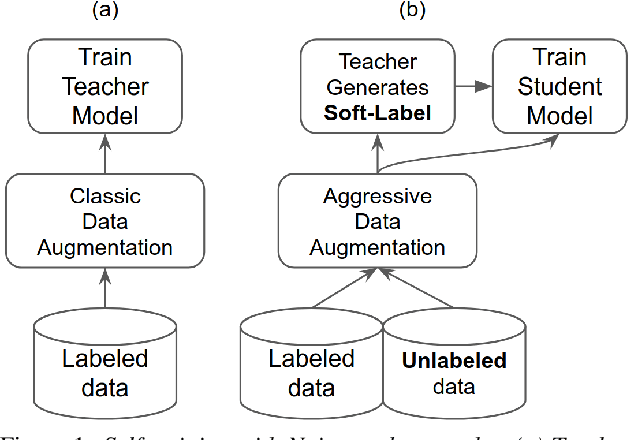
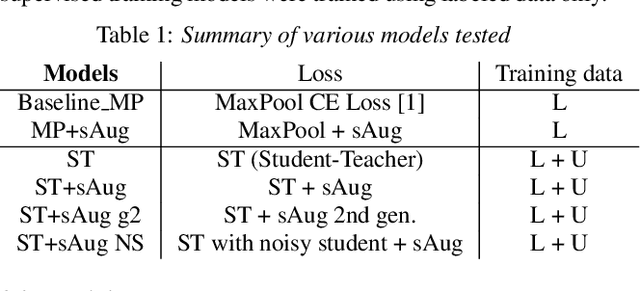

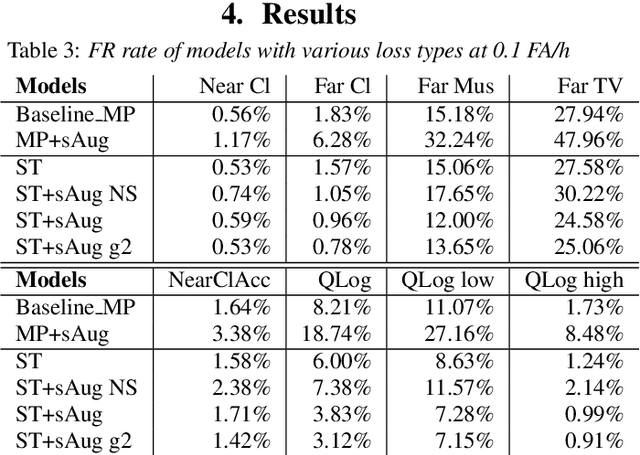
Abstract:We propose self-training with noisy student-teacher approach for streaming keyword spotting, that can utilize large-scale unlabeled data and aggressive data augmentation. The proposed method applies aggressive data augmentation (spectral augmentation) on the input of both student and teacher and utilize unlabeled data at scale, which significantly boosts the accuracy of student against challenging conditions. Such aggressive augmentation usually degrades model performance when used with supervised training with hard-labeled data. Experiments show that aggressive spec augmentation on baseline supervised training method degrades accuracy, while the proposed self-training with noisy student-teacher training improves accuracy of some difficult-conditioned test sets by as much as 60%.
Training Keyword Spotting Models on Non-IID Data with Federated Learning
Jun 04, 2020
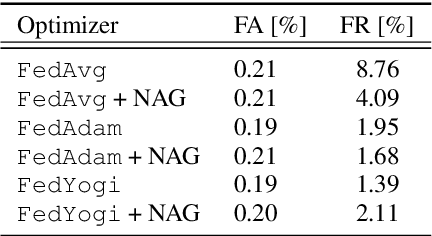

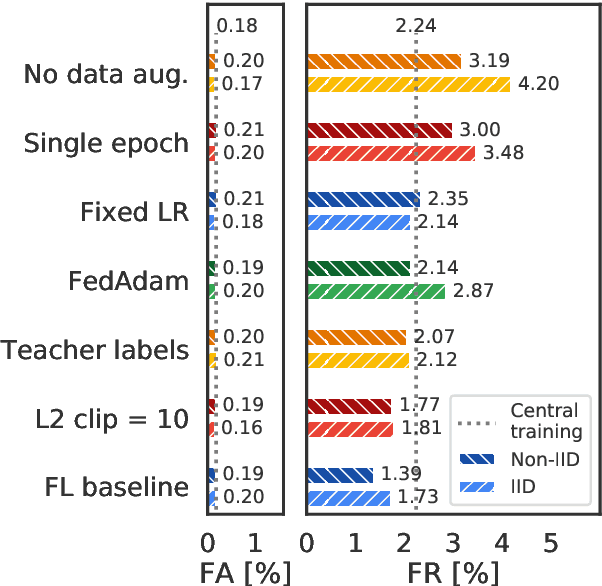
Abstract:We demonstrate that a production-quality keyword-spotting model can be trained on-device using federated learning and achieve comparable false accept and false reject rates to a centrally-trained model. To overcome the algorithmic constraints associated with fitting on-device data (which are inherently non-independent and identically distributed), we conduct thorough empirical studies of optimization algorithms and hyperparameter configurations using large-scale federated simulations. To overcome resource constraints, we replace memory intensive MTR data augmentation with SpecAugment, which reduces the false reject rate by 56%. Finally, to label examples (given the zero visibility into on-device data), we explore teacher-student training.
 Add to Chrome
Add to Chrome Add to Firefox
Add to Firefox Add to Edge
Add to Edge